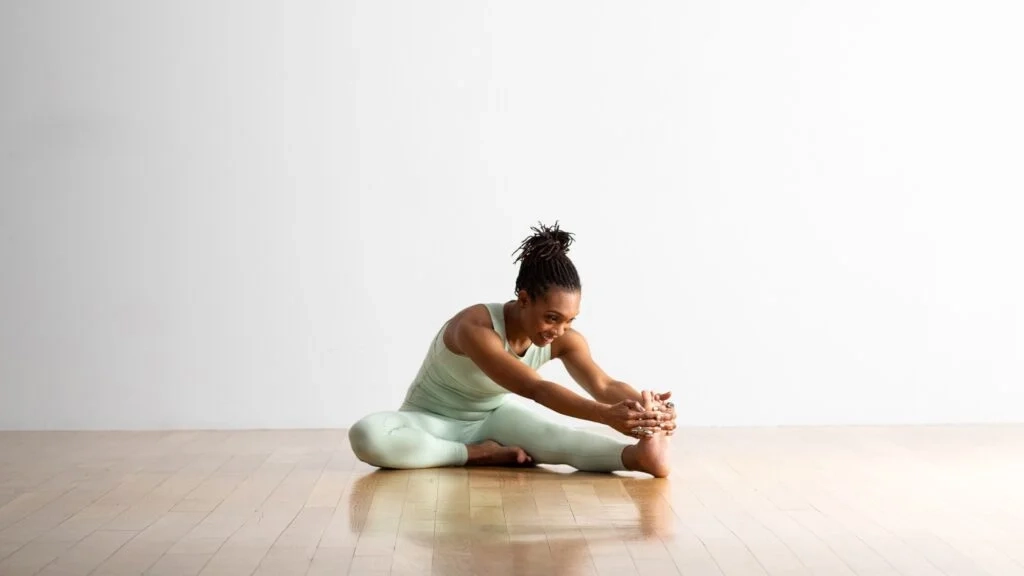Janu Sirsasana Yoga: Embracing Stillness and Unwinding Tension with Head-to-Knee Pose
Table of Contents
Introduction
Janu Sirsasana Yoga, or Head-to-Knee Pose, is a gentle yet powerful yoga posture that embodies the qualities of introspection, surrender, and deep stretching. Derived from the Sanskrit words “janu” (meaning knee) and “sirsa” (meaning head), Janu Sirsasana invites practitioners to cultivate mindfulness, release tension, and create a sense of calmness within.
In this article, we will explore the steps, benefits, variations, and precautions associated with Janu Sirsasana, empowering you to incorporate this soothing pose into your yoga practice.
How to Perform Janu Sirsasana Yoga
To practice Janu Sirsasana Yoga, follow these step-by-step instructions:
Step 1: Start by sitting on the mat with your legs extended straight in front of you.
Step 2: Bend your right knee and place the sole of your right foot against your left inner thigh, allowing the right knee to drop to the side.
Step 3: Ensure that your pelvis is grounded and both sit bones are evenly rooted on the mat.
Step 4: Inhale and lengthen your spine, reaching the crown of your head towards the ceiling.
Step 5: Exhale and hinge forward from the hips, leading with your heart.
Step 6: As you fold forward, aim to reach your hands towards your left foot or ankle. You can hold onto your shin or use a strap around the foot for support if needed.
Step 7: Relax your shoulders away from your ears and maintain a gentle engagement of your core.
Step 8: Breathe deeply and find a comfortable depth in the pose where you feel a gentle stretch along the back of your extended leg.
Step 9: Hold the pose for 5-10 deep breaths, allowing yourself to soften and release tension with each exhalation.
Step 10: Repeat on the opposite side by switching the placement of your legs.

Benefits of Janu Sirsasana Yoga
Regular practice of Janu Sirsasana offers a range of physical, mental, and emotional benefits, including:
a. Deep Stretching: Head-to-Knee Pose provides a deep stretch to the hamstrings, calves, hips, and lower back, increasing flexibility and releasing tension in the legs and spine.
b. Improved Digestion: The gentle compression of the abdomen in this pose massages the digestive organs, stimulating digestion and promoting healthy gut function.
c. Calming the Mind: Janu Sirsasana encourages introspection, mindfulness, and a sense of calmness. The forward folding motion helps to quiet the mind and relieve stress and anxiety.
d. Release of Lower Back Tension: This pose gently stretches the muscles of the lower back, providing relief from tightness and discomfort.
e. Stimulates Energy Flow: Janu Sirsasana activates the flow of energy in the body, specifically along the spine and through the hips and legs, promoting overall vitality and rejuvenation.
f. Improved Posture: Regular practice of Janu Sirsasana helps to improve posture by elongating the spine and strengthening the core muscles.
Variations of Janu Sirsasana Yoga
Explore these variations of Janu Sirsasana Yoga to modify the pose according to your level of practice and flexibility:
a. Supported Janu Sirsasana: Use a bolster or folded blanket under your extended leg to provide support and elevate the hips if you have limited flexibility or tight hamstrings.
b. Half Janu Sirsasana: Instead of folding forward completely, you can rest your torso on your extended leg at a comfortable depth, focusing on the stretch and maintaining a straight spine.
c. Twist Variation: After folding forward, you can incorporate a gentle twist by placing your opposite hand on the outside of your bent knee and twisting towards the bent leg. This variation adds an extra stretch to the spine and the sides of the torso.
Precautions and Contraindications
While Janu Sirsasana Yoga is generally safe for most practitioners, it’s important to consider the following precautions:
a. Avoid practicing Janu Sirsasana if you have a recent or chronic knee, hip, or lower back injury. If you have any concerns or limitations, consult with a healthcare professional or an experienced yoga instructor before attempting this pose.
b. Individuals with sciatica or herniated discs should approach this pose with caution and modify as needed to avoid exacerbating their condition.
c. If you feel any sharp pain or discomfort during the pose, ease out of it and reassess your alignment and depth.
Conclusion
Janu Sirsasana Yoga, the Head-to-Knee Pose, offers a gentle yet profound opportunity to cultivate mindfulness, release tension, and foster a sense of calmness within. With regular practice, this pose provides a deep stretch to the hamstrings, hips, and lower back, improving flexibility and promoting relaxation. Approach Janu Sirsasana with patience, mindfulness, and respect for your body’s limits. Incorporate this soothing pose into your yoga practice to experience the benefits of deep stretching, improved digestion, and a calm and focused mind.





